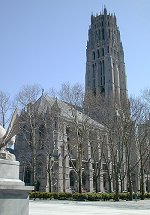
NEW YORK - The Laura Spelman Rockefeller Carillon at The Riverside Church in New York has received a new lease on life, with completion of a 5-year redesign and rebuilding project. Olympic Carillon International of Port Townsend, Washington and Wellington (New Zealand) undertook the massive restoration job on by far the largest and heaviest carillon ever made. The carillon, a gift of John D. Rockefeller jr. in memory of his mother, transposes down a perfect 4th and is situated some 110 metres up in a huge limestone tower, high above the 'City That Never Sleeps'.
Timothy Hurd ______________________________________________
The original carillon of 72 bells by Gillett & Johnston of Croydon, England was unsympathetically altered in 1956, when 56 G&J mid-range bells were melted down and recast by Van Bergen of Heiligerlee (The Netherlands). Only 16 of the original heavy bells by Gillett & Johnston still survive, the heaviest of these being a swinging bourdon C0 bell weighing nearly 41,000 lbs (18,600 kg).
'TURNING BACK THE CLOCK'
The primary object of the recent work by Olympic Carillon was to reverse the damage of 1956 and to redesign the frame and transmission so that the carillon can be heard distinctly at ground level.
58 new bells cast by Whitechapel of London were installed, replacing all of the Van Bergen bells. Profiles of the first half-octave of new bells (f1 to b-flat1) are exact G&J 'clones', the second half-octave (b1 - e2) uses a transitional profile adjustment, bell-by-bell, merging into the 46-bell upper register which uses heavy (modern English) profiles by Whitechapel. The bell design research included measuring the profiles of the 16 G&J bass bells, precisely analyzing the chemical composition of the bell metal, and plotting all of the harmonic frequencies within each bell with a digital frequency analysis system.
Tuning of the new bells conformed to the 'high third' just intonation tonal complexion of the original G&J bells; extensive archival research confirmed the extent of treble stretching on the original 1930 trebles (destroyed by Van Bergen) and this scheme was further refined and applied to tuning the new bells, to produce an authentic G&J sound, in a carillon of immense carrying power.
INSTALLATION RE-NEWED
Both the old playing cabin and the machine room with the old barrel clock and pneumatic actuator mechanism were completely demolished. In all, 22 tons of masonry, 15 tons of steel beams, and 10 tons of machinery were removed. All of this material and all old and new bells passed through a maze of ventilation shafts and a 45" x 45" (about 1.15 m2) opening in the bass belfry floor.
A new treble frame for bells #22-74 was constructed in the location of the old playing cabin. The original treble frame was mounted just above the old clavier room, so the treble bells spoke directly into the roof of the structure. This is one of the reasons why the original G&J small bells could not be heard on the ground. Most mid-range bells and some bass bells were also repositioned to assure that their sound is no longer obstructed.
Since the old transmission was an inefficient side transmission, the orientation of the action from a north-south side transmission was shifted to an east-west central transmission, thus allowing a center transmission.
Furthermore a new all stainless steel transmission, fully-adjustable stainless clappers with weld-deposited nickel strike rings, and stainless steel ball-bearings was installed. A set of 74 interchangeable clapper balls of different weights was fabricated for the 58 new bells, to achieve maximum projection of sound. The carillon can now be heard very easily at ground level, within a six city block radius of the Church, ten blocks if wind conditions are right.
The five-bell swinging peal was renovated with new motors and control mechanism. The c1 swinging bell of 2.5 tonne and its framework were also moved up one level for better sound projection.
The original clappers for bells #1-16 were restored and resurfaced with ferro-nickel strike spots. Tenor range bells in the east and west frames received new steel headstocks and their strike axis was shifted by 90°.
OLYMPIC UNIVERSAL KEYBOARD
A new playing room with climate control and a six-octave Olympic universal standard keyboard was installed in the location of the previous machine room. The clavier is made in west African padauk and stainless steel, based on the 1996-97 prototype standard at Wellington (New Zealand). Decorative motifs on the new clavier and bench echo the neo-gothic ornamentation in the church.
For the installation of the new clavier it had to be taken apart completely and re-assembled on the belfry floor. With the placement of a matching six-octave practice clavier in the carillonneur's studio the renovation project was completed. The practice keyboard has a novel, adjustable spring system offering the 'feel' of a main clavier.
The re-dedication of the carillon was played by Milford Myhre on 17 October 2004. A champagne reception was held in the Church following the recital, attended by many carillonneurs from the surrounding Eastern seaboard area.
